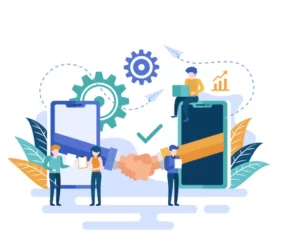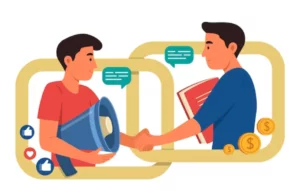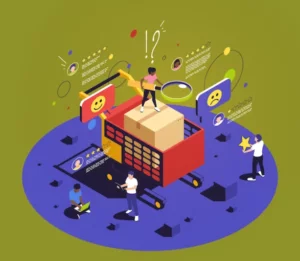Understanding customer acquisition tactics is crucial if you lead a business or want to do so shortly. Most new companies have a hard time drawing in clients at first, and this is because a negligible percentage of the population is already familiar with your company’s offerings. Therefore, entrepreneurs need to use the absolute finest client acquisition techniques for startups to succeed.
What does “Customer Acquisition” entail?
Simply said, customer acquisition is the process of gaining new clients. Any company, organization, or entrepreneur needs to have a plan in place for how they will go about attracting new clients or customers.
Referrals, loyalty programs, and other similar initiatives are just a few of the many effective client acquisition techniques available to businesses today.
The word “client acquisition” has diverse connotations for various enterprises. This, however, is related to three main development factors and the three-step process of obtaining, maintaining, and expanding.
- GET: In business, the word “get” refers to bringing in new clients. As so, we have completed Step 1 of the user acquisition process. Customers are attained through extensive promotion across many mediums.
- KEEP: What percentage of these clients can you expect to keep coming back? In the end, it’s all about the consumer value you deliver. The typical turnover rate is 5-7% but varies widely between sectors. It’s essential always to have something new to offer them if you want to maintain their business. Consider Facebook as an illustration. It’s now easier than ever to interact with Facebook’s millions of users. The economic model is built to keep users coming back for more, and most of it is tied to user-generated content.
- GROW: Is a significant portion of your clientele contributing to your company’s expansion? In other words, what percentage of your consumers are open to buying more products? Some of these people may become referrals for your company, while others won’t. These elements work together to form the foundation of “customer acquisition.”
Steps of Customer Acquisition for Startups

Acquiring customers is a critical process for any startup and requires a well-planned strategy. Below are some of the steps involved in customer acquisition for startups:
- Identify target audience: The first step in customer acquisition is identifying your target audience. You must know who your ideal customers are and their needs and pain points. You can use market research and customer profiling to identify your target audience.
- Build a marketing plan: Once you know your target audience, you need to create a marketing plan to help you reach out to them. Your marketing plan should include a mix of channels, like social media, , content marketing, email marketing and paid advertising.
- Develop a value proposition: Your value proposition sets you apart from your competitors. It’s a statement that explains what you offer and how it benefits your customers. Your value proposition needs to be clear, concise, and compelling.
- Create a sales funnel: A sales funnel is a series of steps a customer goes through before making a purchase. It starts with awareness and ends with conversion. Your sales should be designed to move customers through each stage of the funnel and convert them into paying customers.
- Offer incentives: To encourage customers to try your product or service, you can offer incentives, such as discounts, free trials, or samples. Incentives reduce the risk for customers and increase the likelihood that they will try your product.
- Measure and optimize: Customer acquisition is an ongoing process, and you need to continuously measure and optimize your strategies. Use analytics tools to track your metrics and identify areas where you can improve. Refine your marketing strategies based on the data and feedback from your customers.
Customer Acquisition Strategies for Startups: How to Attract and Convert Your Ideal Customers

Starting a new business is a thrilling experience, but acquiring customers can be a daunting task. You have a great product or service, but how do you ensure the right people find it? This blog will explore some proven customer acquisition strategies for startups, along with real-world examples.
1. Content Marketing
Content marketing is a powerful way to pull potential customers by providing them with valuable and engaging content that addresses their pain points or interests. This can include blog posts, videos, e-books, webinars, or any other content that educates, entertains, or inspires your target audience.
For example, Hubspot, a marketing software company, offers free content and resources to help businesses improve their inbound marketing. Their blog covers topics such as SEO, social media, email marketing, and more. By creating high-quality content that solves customers’ problems, Hubspot has become a go-to resource for marketing professionals and has grown its customer base to over 100,000 businesses.
2. Social Media Marketing
Social media platforms such as Facebook, Instagram, Twitter, and LinkedIn are great ways to promote your brand and engage with potential customers. Social media allows you to share your brand story, showcase your products or services, and interact with your audience in real time.
For instance, Glossier, a beauty brand, has built a strong following on Instagram by sharing user-generated content and highlighting its customers’ experiences with its products. Glossier’s Instagram feed features photos and videos of real people, not just models, which makes the brand feel relatable and inclusive. By using social media to showcase its customers and build a community around its brand,
Glossier has been able to attract a loyal following of over 2 million Instagram followers.
3. Referral Programs
Referral programs are a powerful way to incentivize your existing customers to refer new customers for your business. By offering a reward or discount to customers who refer their friends or family, you can leverage your existing customer base to acquire new customers at a lower cost.
For example, Dropbox, a cloud storage company, grew its user base from 100,000 to 4 million in just 15 months by offering free storage to customers who referred new users. This referral program was easy to share and track, and it helped Dropbox quickly gain a large and loyal user base.
4. Paid Advertising
Paid advertising allows you to reach potential customers with targeted ads on platforms like Google, Facebook, Instagram, and LinkedIn. By targeting specific demographics, interests, or search terms, you can increase the likelihood of converting those most likely to be interested in your product or service.
For instance, Dollar Shave Club, a subscription-based razor company, used humorous and engaging ads to drive customer acquisition. Their viral video “Our Blades Are F***ing Great” helped the company gain over 12,000 new subscribers in the first 48 hours after its release.
5. Influencer Marketing
Influencer marketing comprises partnering with social media influencers/bloggers who have a large following to promote your brand or products. By leveraging the trust and influence of these entities, you can reach a wider audience and gain credibility with potential customers.
MVMT, a watch brand, has worked with influencers to reach new audiences and drive sales. By partnering with fashion and lifestyle influencers on Instagram, MVMT has been able to showcase its products in an aspirational and relatable way to a younger demographic.
6. Public Relations
Public relations involves generating media coverage and press mentions to build awareness of your brand. You can reach new audiences and gain credibility with potential customers by securing coverage in relevant publications or websites.
For example, Airbnb used PR to build buzz around its launch and generate interest from potential customers. By securing coverage in major media outlets and leveraging user-generated content, Airbnb established itself as a disruptive and innovative player in the travel industry.
7. Events and Experiences
Hosting events or providing unique experiences can be a powerful way to engage with potential customers and build brand loyalty. By creating memorable experiences that showcase your brand and values, you can differentiate yourself from competitors and create a lasting impression.
Airbnb also uses this strategy by offering unique experiences to travelers as a way to differentiate itself from traditional hotel offerings. By providing curated and authentic experiences, Airbnb has created a loyal community of travelers seeking unique and original travel experiences.
Key Tools That Help Measure Customer Acquisition

Several tools can be used to evaluate customer acquisition strategies. Here are a few examples:
- Google Analytics: This tool provides detailed information on website traffic, including the number of visitors, where they came from, and how they interacted at your website. It can help you understand which marketing channels drive the most traffic and conversions.
- A/B testing tools: A/B testing allows you to compare two different marketing campaign versions to see which one performs better. Optimizely and VWO can help you set up and run A/B tests to optimize your customer acquisition strategies.
- Customer relationship management (CRM) software: CRM software like Salesforce or HubSpot can help you track and manage your interactions with potential and existing customers. This can help you identify patterns in customer behavior and tailor your acquisition strategies accordingly.
- Social media analytics: Social media platforms like Facebook and Twitter provide tools that can help you understand how your social media campaigns perform. These tools can help you track engagement, reach, and conversions.
- Surveys and feedback tools: Gathering customer feedback can help you understand what’s working and what’s not in your customer acquisition strategies. Tools like SurveyMonkey and Qualtrics can help you create and distribute surveys to your customers.
Using these tools, you can evaluate your customer acquisition strategies and make data-driven decisions to optimize your marketing efforts.
Metrics For Evaluating Conversions In Ecommerce
- Customer Acquisition Cost (CAC) – This is the cost incurred by the company to acquire one new customer. The formula for CAC is the total cost of sales and marketing/number of customers acquired, and it helps the company to evaluate the effectiveness of its marketing and sales campaigns.
- Customer Lifetime Value (CLV) – This metric helps the company evaluate the customer’s long-term value. It is the total revenue a customer is expected to generate for the company over their lifetime. By comparing CLV to CAC, the company can determine if its customer acquisition strategy is profitable.
- Conversion Rate – This is the percentage of website visitors who take a specific action, such as making a purchase or filling out a form. By tracking the conversion rate, the company can determine which marketing campaigns or website design changes are quite effective at converting visitors into customers.
- Retention Rate – This is the percentage of customers who continue to purchase from the company over time. By measuring the retention rate, the company can determine if its customer acquisition strategy attracts the correct type of customers who are likely to stick around and continue making purchases.
- Net Promoter Score (NPS) – This customer satisfaction metric measures the likelihood of a customer recommending the company to others. By measuring NPS, the company can determine if its customer acquisition strategy attracts customers likely to become brand advocates and refer others to the company.
Conclusion
In conclusion, customer acquisition is critical to any startup’s success. By using a combination of these strategies, you can attract and convert your ideal customers and build a sustainable and profitable business. Remember to experiment, measure, and iterate on your strategy to find the best ones for your business.
FAQs
What is the customer retention strategy?
Customer retention strategy is a method of tactics and techniques businesses use to keep customers returning and build long-term relationships with them.
Why is customer retention necessary for startups?
Customer retention is critical for startups to ensure long-term success. By retaining customers, startups can lower customer acquisition costs, increase customer lifetime value, and build a loyal customer base.
What are some effective customer retention strategies for startups?
Some effective customer retention strategies for startups include personalized communication, excellent customer service, loyalty programs, and exclusive deals and discounts.
How can startups measure the effectiveness of their customer retention strategies?
Startups can measure the effectiveness of their customer retention strategies by tracking metrics such as customer lifetime value, retention rate, and repeat purchase rate.
How can startups use customer feedback to improve their customer retention strategies?
Startups can use customer feedback to identify areas for improvement in their customer retention strategies and gain insights into what their customers value most and what they need to keep coming back.
What role does employee training and development play in startup customer retention?
Employee training and development play a crucial role in customer retention for startups by ensuring that employees are equipped with the skills and knowledge to provide excellent customer service, build relationships with customers, and identify opportunities for upselling and cross-selling.
How often should startups review and update their customer retention strategies?
Startups should review and update their customer retention strategies regularly to ensure that they are meeting the changing needs of their customers and adapting to new market trends and technologies.



